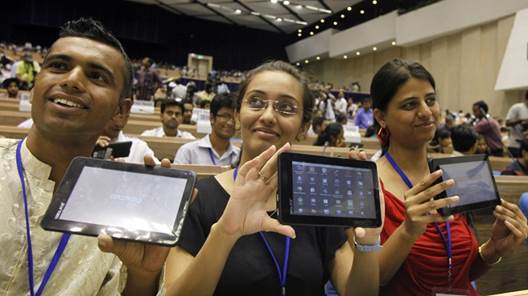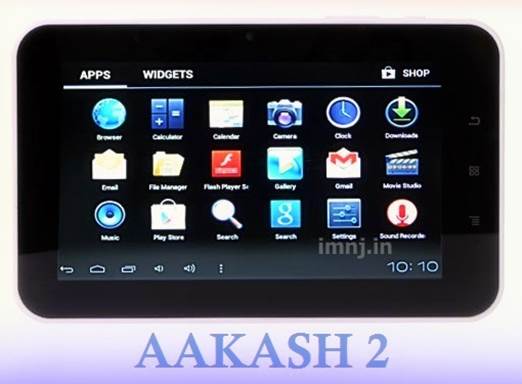The vision behind the Aakash tablet is to
bridge the digital divide in the country and help the students from rural and
socio-economically weaker sections of the society to have access to modern
technology and education.
Though the Aakash appears far away from
mainstream tablets, but it is nevertheless important. For a country that has
long grappled with a poor education system and no hope for rebuilding of the
necessary infra-structure, the Aakash could play a key role in turning things
around.
We need to empower our significantly large
youth populace most of them in the rural areas of the country with quality and
modern education. The tablet could very well play a key role in accomplishing
it.

Though the Aakash appears far away from
mainstream tablets, but it is nevertheless important.
From Sakshat to Aakash
It all started back in 2011 when Union
Minister of Human Resource Development, Kapil Sibal, announced an ambitious
indigenous low-cost device that would be comparable to the One Laptop per Child
(OLPC) initiative. While the OLPC initiative was aimed at rural and
underprivileged students, the Indian government’s device was initially intended
for urban college students.
Still, not many people know that it wasn’t
the first time a ‘Made in India’ computer was coined. In early 2000, a
prototype Simputer was produced in small numbers. Bangalore-based CPSU and
Bharat Electronics Ltd even manufactured around 5,000 Simputers during 2002-07.
In 2009, a number of states announced plans to order OLPCs. But then the
project never took off.
In July 2010, Kapil Sibal unveiled a
pro-totype tablet, dubbed as the Sakshat. The price of the device showcased was
projected at $35, which would eventually drop to $20 and ultimately to $10. After
the device was exhibited, OLPC Chairman Nicholas Negroponte offered full access
to OLPC technology to the Indian team for free.
While it seemed the country was set to
deliver the world another masterpiece of innovation, the Sakshat project
suffered its first blow when the company hired to build the Sakshat, HCL
Infosystems, failed to prove that they had at least Rs. 60 crore in bank
guaranteed funds, as mandated by the government. As a result, the government
dropped HCL from the project and re-advertised the tender.
The Sakshat tender was then bagged by
DataWind, a UK-based manufacturing and marketing company that produces wireless
web access products, originally founded in Montreal.
Finally on October 5, 2011, Kapil Sibal
unveiled the ultralow cost tablet, called the Aakash. The device, earlier
nicknamed as Sakshat, looked quite different from the prototype flaunted by the
minister previous year. Again expectations ran high amid massive buzz in the
country and even across the shores. DataWind went on to register pre-orders for
the 1.4 million units of the UbiSlate 7 (commercial version of the Aakash)
within just two weeks after releasing the device online.

Still,
not many people know that it wasn’t the first time a ‘Made in India’ computer
was coined
But how many tablets were shipped? One of
the first controversies that came to the light was the fall out between the
government, DataWind and IIT-Rajasthan. The government was apparently unhappy
with DataWind for trying to the sell the commercial version of the device
before the government releasing the official Aakash tablet. DataWind also drew
flak over the ‘poor performance’ of the device, as reported by IIT-Rajasthan.
DataWind in its defence said IIT’s test criteria didn’t make sense, as it
included conditions such as water resistance, where the tablet is kept in a
rain chamber supplying rain at a rate of no less than 4 inches per hour. The
government asked IIT to withdraw its ‘military-level’ test criteria and
stressed focussing on ‘consumer friendly’ features. Later, IIT-Rajasthan was
pulled out of the project.
Aakash 2.0 replaces the Aakash
On November 11, 2012, President Pranab
Mukherjee unveiled the Aakash 2 at an event in New Delhi. DataWind designed,
developed and manufactured the Aakash 2.0 whereas the device’s platform was
developed by IIT Bombay that includes 3D-modelling, C++ programming, remote and
collaborative training applications, robotic control and live assessment tools.
IIT Bombay partnered with the Center for Development of Advanced Computing
(C-DAC), to assist with the hardware testing and logistics.
The Aakash 2.0 specifications include a
7-inch multi-touch 4-point capacitive display with 800 x 480 pixel resolution,
Android 4.0 Ice Cream Sandwich OS, 512 MB of RAM, Cortex A8 1 GHz processor,
4GB built-in storage, microSD card slot that supports storage up to 32 GB,
micro USB, Wi-Fi b/g/n and a 3,000 mAh battery.

On
November 11, 2012, President Pranab Mukherjee unveiled the Aakash 2 at an event
in New Delhi.
The Aakash 2.0 was showcased at the United
Nations on November 28, 2012. UN Secretary-General Ban Ki-Moon showered praise
on India’s efforts to bring modern technology to everyone’s door steps. He
said, “We know technology is not an end in itself. The key is to empower people
to make the most of their own potential. Information and communications
technologies are engines of economic growth and development and can help
transform people’s lives. They are great enablers helping people communicate
across distances, facilitating trade and commerce and providing better access
to health care and education.”
Aakash 2: A Made in China device?
Days before it was unveiled at the UN, the
Aakash 2 ran into another controversy with media reports claiming the device
was a Made in China device. Reports said DataWind had procured the tablets
off-the-shelf from manufacturers in China for $42 (Rs. 2,263 then), exactly the
price at which they sold these to the Indian government. DataWind, however,
denied the allegations. DataWind also put an explanation on its website
detailing where the Aakash 2 tablets are made and assembled.
DataWind’s CEO Suneet Singh Tuli, however,
believes ‘Made in India’ tag is important. When we contacted Mr. Tuli and he
said, “We believe that Made in India is important and specific Indian level
value-adds to should be the criteria for future tenders. This would create
defined criteria for the ‘Made in India’ tag, so that there is no controversy.”
(Full interview: http://dgit.in/datatuli)
Tuli is also hopeful India can develop a
‘Made in India’ tablet on a large scale. “a focused effort should be made to
develop indigenous manufacturing but with the maturity to understand that
components will come from around the world,” he added.
Why Aakash can make a difference? The
world’s biggest democracy has shown great promise in the past, but it’s been
held back by education and infrastructure problems. The success of Aakash could
completely change this, in fact it could lay foundation for a modern and
improved education infra-structure in India which we’ve all been dreaming and
striving for so long.
That being said, we have to be honest to
ourselves. The entire education system cannot rely on tablet hardware for the
overhaul it is striving and to deliver the quality knowledge to the students.
The success of the Aakash tablet is just part of a goal, not the ultimate goal.
But that is easier said than done. The
government has to create an environment where the tablet and the related
benefits are optimally harnessed. It may seem difficult at this stage, but it’s
definitely not impossible. Moreover, the government has to work on the
economics and ensure the subsidy (whopping 50 percent on each unit) does not
hurt it in long-term.
Unlike other ongoing state run projects,
the government should try to make it commercially successful, which would set
an example for other schemes. A lot of hard work has to be done on awareness.
People should know about it. We don’t expect the government to run Pulse Polio,
free cycle, Mid-Day meal or Aadhar like campaign across the country, but there
has to be some work and exposure at the ground level.
We feel the Ministry of Human Resource
Development’s described vision precisely defines why ultra-low-cost tablet or
Aakash-like technology is important for India and its large young population.
It says on its site: “... [The] young population should be considered as an
invaluable asset which if equipped with knowledge and skills, can contribute
effectively to the development of the national as well as the global economy.
The vision is to realize India’s human resource potential to its fullest in the
education sector, with equity and inclusion.”